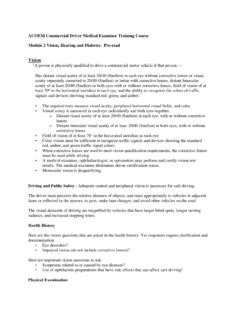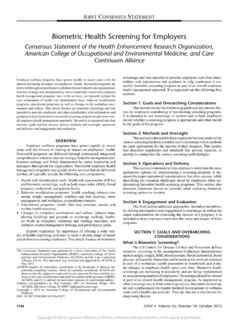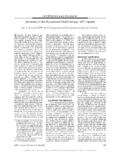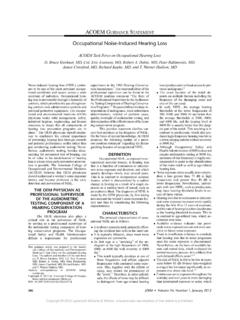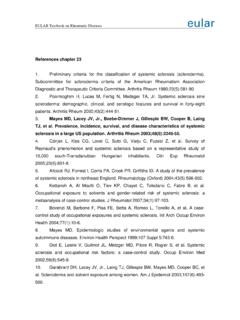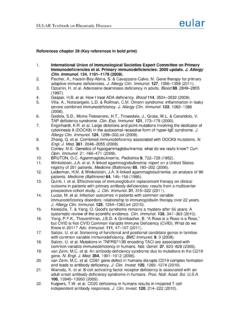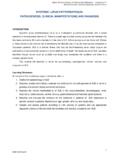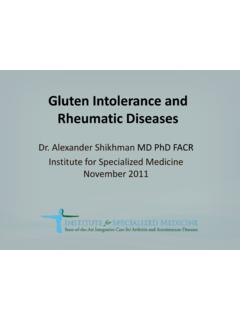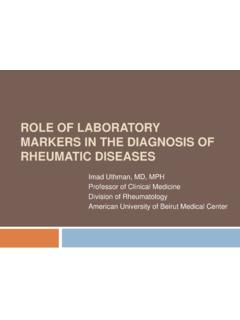Transcription of ACOEM Commercial Driver Medical Examiner Training …
1 ACOEM Commercial Driver Medical Examiner Training Program Module 5 Musculoskeletal, Other Diseases Musculoskeletal 49 CFR (b)(1)(2)(7) 49 CFR (b)(1) "A person is physically qualified to drive a Commercial motor vehicle if that person Has no loss of a foot, a leg, a hand, or an arm, or has been granted a skill performance evaluation certificate pursuant to " 49 CFR (b)(2) "Has no impairment of: (i) A hand or finger which interferes with prehension or power grasping; or (ii) An arm, foot, or leg which interferes with the ability to perform normal tasks associated with operating a Commercial motor vehicle; or any other significant limb defect or limitation which interferes with the ability to perform normal tasks associated with operating a Commercial motor vehicle; or has been granted a skill performance evaluation certificate pursuant to " 49 CFR (b)(7) "Has no established Medical history or clinical diagnosis of rheumatic, arthritic, orthopedic, muscular, neuromuscular, or vascular disease which interferes with his/her ability to control and operate a Commercial motor vehicle safely.
2 " Relevance to Driving Disorders of the musculoskeletal system affect driving ability and functionality necessary to perform heavy labor tasks associated with the job of Commercial driving. Medical certification means the Driver is physically able to safely drive and perform nondriving tasks as described in the Driver role section of the Federal Motor Carrier Safety Administration (FMCSA) Medical Examination Report form. drivers have a multitude of job demands. The least physically demanding part may be the actual driving. For example, the duties of a Commercial Driver may include loading and unloading, making multiple stops, driving cross-country and in heavy city traffic, working with load securement devices, and changing tires.
3 Other common driving tasks include: Manipulating the wheel. Shifting gears. Maintaining pressure on the pedals. Braking. Monitoring traffic. Other job tasks include: Performing pre- and post-trip safety checks. Ensuring the vehicle is loaded properly. Securing the load. Evaluating and managing vehicle breakdowns. Responding to emergency situations. Health History and Physical Examination The general purpose of the history and physical examination is to detect the presence of physical, mental, or organic conditions of such character and extent as to affect the ability of the Driver to operate a Commercial motor vehicle (CMV) safely. This examination is for public safety determination and is considered by FMCSA to be a Medical fitness for duty" examination.
4 As a Medical Examiner , your fundamental obligation during the musculoskeletal assessment is to establish whether a Driver has the musculoskeletal strength, flexibility, dexterity, and balance to maintain control of the vehicle and safely perform nondriving tasks. The examination is based on information provided by the Driver (history), objective data (physical examination), and additional testing requested by the Medical Examiner . Your assessment should reflect physical, psychological, and environmental factors. Medical certification depends on a comprehensive Medical assessment of overall health and informed Medical judgment about the impact of single or multiple conditions on the whole person. During the physical examination, you should ask the same questions as you would for any individual who is being assessed for musculoskeletal concerns.
5 Adapt the observation, inspection, palpation, and screening tests of the general musculoskeletal examination to ensure that the physical demands of Commercial driving are assessed ( , rotation of the outstretched arms against resistance as if turning a large steering wheel, movement of the legs in braking and clutching, etc.). The FMCSA Medical Examination Report form includes health history questions. Additional questions should be asked to supplement information requested on the form. You may ask about musculoskeletal symptoms. Any musculoskeletal or neuromuscular condition should be evaluated for the nature and severity of the condition, the degree of limitation present, the likelihood of progressive limitation, and the potential for gradual or sudden incapacitation.
6 You must review and discuss with the Driver any "yes" answers Does the Driver have: A muscular disease ? A missing hand, arm, foot, leg, finger, or toe? A nonfunctioning or dysfunctional hand, arm, foot, leg, finger, or toe? An injury or disease of the spine? Chronic low back pain? Questions that you may ask include Does the Driver : Have physical limitations caused by weakness, pain, or decreased mobility and range of motion (nature and degree)? Use musculoskeletal agents (effects and/or side effects)? Have mild, moderate, or severe chronic musculoskeletal pain (frequency and intensity)? You must evaluate if the Driver has: A missing or impaired leg, foot, toe, arm, hand, or finger? Sufficient power grasp and prehension of hands and fingers to maintain steering wheel grip?
7 Sufficient strength and mobility in lower limbs to operate pedals properly? A perceptible limp? Signs of previous spine or other musculoskeletal surgery? Deformities of the spine and/or torso? Sufficient mobility and strength of spine and/or torso to drive safely and perform other job tasks? Limitations of motion of the spine and/or torso? Spine, torso, and/or other musculoskeletal tenderness? NOTE: As a Medical Examiner , you determine if the severity of a reversible or progressive musculoskeletal disease interferes with driving ability. If findings so dictate, radiology and other examinations should be used to diagnose congenital or acquired defects or spondylolisthesis and scoliosis. Examination by a neurologist or physiatrist who understands the functions and demands of Commercial driving may be required to assess the status of the disease .
8 However, as a Medical Examiner , it is your responsibility to determine certification status. You must document discussion with the Driver about Any affirmative musculoskeletal history, including if available: o Onset date and diagnosis. o Medication(s), dose, and frequency. o Any current limitation(s). Potential negative effects of medication used while driving, including over-the-counter medication. Any abnormal finding(s), noting: o Effect on Driver ability to operate a CMV safely. o Necessary steps to correct the condition as soon as possible, particularly if the untreated condition could result in more serious illness that might affect driving. Any additional tests and evaluation. Medical fitness for duty includes the ability to perform strenuous labor.
9 Overall requirements for Commercial drivers as well as the specific requirements in the job description of the Driver should be deciding factors in the certification process. Musculoskeletal Topics Neuromuscular Diseases As a group, neuromuscular diseases are usually insidious in onset and slowly progressive. The rate of progression will vary and is generally measured in months to years. Rare neuromuscular diseases may be episodic producing weakness over minutes to hours. You must consider the effects of neuromuscular conditions on the physical abilities of the Driver to initiate and maintain safe driving including steering, braking, clutching, getting in and out of vehicles, and reaction time. Examination by a neurologist or physiatrist who understands the functions and demands of Commercial driving may be required to assess the status of the disease .
10 As the Medical Examiner , you determine certification status. Autonomic Neuropathy - Autonomic neuropathy affects the nerves that regulate vital functions, including the heart muscle and smooth muscles. Conditions Associated with Abnormal Muscle Activity - This group of disorders is characterized by abnormal muscle excitability caused by abnormalities either in the nerve or in the muscle membrane. Congenital Myopathies - Congenital myopathies are a group of disorders that may be distinguished from others because of specific, well-defined structural alterations of the muscle fiber and may be progressive or nonprogressive. These disorders include: Central core disease . Centronuclear myopathy. Congenital muscular dystrophy.
